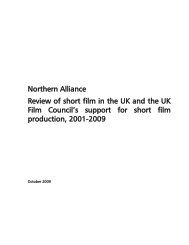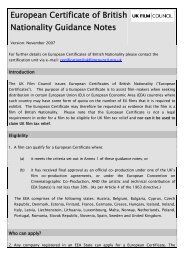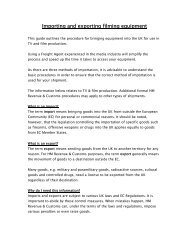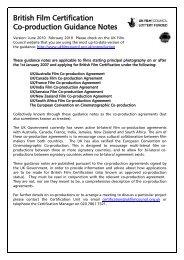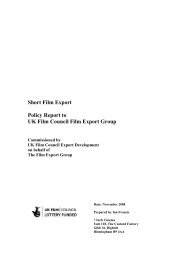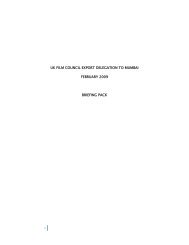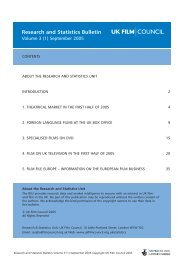Barriers to Diversity in Film – A Research Review – Aug 07
Barriers to Diversity in Film – A Research Review – Aug 07
Barriers to Diversity in Film – A Research Review – Aug 07
You also want an ePaper? Increase the reach of your titles
YUMPU automatically turns print PDFs into web optimized ePapers that Google loves.
In a major report on the black and Asian experience, many m<strong>in</strong>ority<br />
ethnic groups said that they felt under-represented <strong>in</strong> British films and<br />
wanted <strong>to</strong> see films more closely related <strong>to</strong> the day-<strong>to</strong>-day lives of<br />
ord<strong>in</strong>ary African Caribbeans and South Asians <strong>in</strong> Brita<strong>in</strong> (BFI 2000).<br />
The same report criticises East is East (1999), as does another author<br />
(Aftab 2004). The move of this s<strong>to</strong>ry from theatre saw white<br />
characters added <strong>to</strong> the film, and a bad guy was built up <strong>to</strong> vilify (Aftab<br />
2004). The Asian father is represented as a brutal hypocrite, who<br />
<strong>in</strong>sists his children must respect his cultural beliefs (compare the<br />
‘cricket test’ by Norman Tebbit 5 ). This film was clearly an attempt at<br />
ga<strong>in</strong><strong>in</strong>g a white audience, but Monsoon Wedd<strong>in</strong>g (2001) did not add<br />
white characters <strong>in</strong> this way and still attracted a large audience (Aftab<br />
2004).<br />
Even <strong>in</strong> the USA, where there are strong black and other ac<strong>to</strong>rs from<br />
m<strong>in</strong>ority groups, the number of films on racial and ethnic issues is<br />
limited (Robson 2002). In Brita<strong>in</strong> it is even more restricted,<br />
notwithstand<strong>in</strong>g the growth of the UK-born m<strong>in</strong>ority ethnic group<br />
population (for example, 90% of under 14s from m<strong>in</strong>ority ethnic<br />
groups have been born <strong>in</strong> the UK.)<br />
A study on m<strong>in</strong>ority-led companies found that m<strong>in</strong>ority ethnic groups<br />
argued negative stereotypes were often discernible <strong>in</strong> film (IES 2004).<br />
5 Norman Tebbitt asked South Asian and Caribbean-orig<strong>in</strong> people <strong>to</strong> seriously consider who they supported <strong>in</strong> national cricket<br />
teams. He argued that the ‘cricket test’ could be applied <strong>to</strong> determ<strong>in</strong>e allegiance <strong>to</strong> England. By this he meant that people could<br />
not support England and the West Indies. People had <strong>to</strong> support England <strong>to</strong> be truly English (Brah 1992).<br />
C:\Documents and Sett<strong>in</strong>gs\mcorless\Desk<strong>to</strong>p\Intranet\<strong>Barriers</strong> <strong>to</strong> <strong>Diversity</strong> <strong>in</strong> <strong>Film</strong>_DS_RB 20 <strong>Aug</strong><br />
<strong>07</strong>.doc<br />
129



